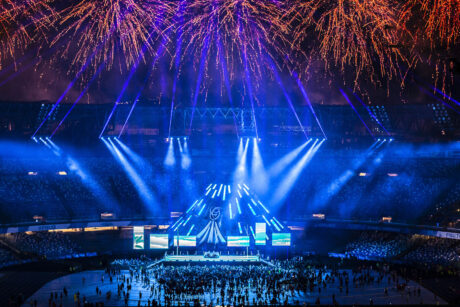
NAPLES, ITALT – Leading Italian lighting and visuals designer Giovanni Pinna came hot off Vasco Rossi’s Non Stop Live 2019 stadium tour and straight into the Opening Ceremony of the 2019 Summer Universiade – World University Games – event, staged at the Stadio San Paolo, Naples. Several elements of the stadium were restored in time to host the Games, which, after the Olympics, is the largest multi-sport event in the world.
More details from Robe (www.robe.cz):
Giovanni chose to use nearly 350 Robe moving lights – 136 x MegaPointes, 112 x Spiiders, and 36 x Tarrantulas and 60 x LEDBeam 150s – to assist in him in creating a fabulous looking and epic OC show with multiple WOW factors.
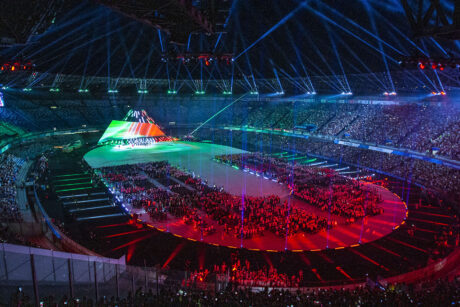
Giovanni was approached by LA-based event and ceremonies producers BWS (Balich Worldwide Shows). They wanted an Italian LD and were impressed by his vision for the spectacular large-scale show and the many event design references on his CV.
Giovanni is no stranger to lighting stadium shows. Working alongside a highly talented team from BWS, this one came alive with vibrance, color, movement and a choreographed cast of several hundred which had to be lit as well as individual artists including Andrea Bocelli, plus acrobats, sportspeople and set props. The largest of these was a giant replica of rumbling volcano Mount Vesuvius sitting in one corner of the pitch overlooking the proceedings!
There were also intricate large format projections onto the pitch which had to be ‘lit around’.
Giovanni knew he needed extremely bright lights, so the MegaPointes, Spiiders and Tarrantulas were perfect! He used them to highlight the vast field-of-play, while the punch and shuttering accuracy of the MegaPointes enabled him to keep cast key lighting away from the projections.
BWS’s Lida Castelli assisted by show director Marco Boarino was artistic director of both the 2019 Summer Universiade ceremonies (Opening and Closing). She produced the shows, together with a large team – including project manager Alessandra Rossetti and technical manager Matteo Tagliabue – who developed the storyboard based on local Neapolitan history, culture and geography.
The theatrical show element was around 2 hours long – out of a three-and-a-half-hour OC event – that also incorporated an athlete’s parade, speeches and various other protocol related sections, all of which needed appropriate lighting.
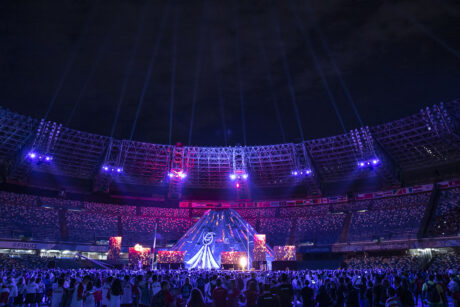
The first rule of stadium lighting is to make sure you fill the venue with enough lighting, so Giovanni incorporated 350 of the stadium’s new lighting fixtures, plus another 400 fixtures in addition to the 350 Robes.
These were positioned on two levels – on 28 trusses installed on the stadium roof and a heavily concentrated ‘artillery’ of lights around the perimeter of the pitch. It might sound like a lot, but the 1000+ lights were soon consumed on a show of this magnitude, so each one of them had to work very hard!
‘With all these Robes I knew I would have plenty of variety, options and sheer firepower to create the right show,” Giovanni commented. “The focus was on creating big, bold pictures and statements with the lighting, then picking out details when required, and ensuring that the audience – both live and on TV – enjoyed the best time!”
A massive job for lighting company BOTW was rigging trusses 360 degrees all around the stadium roof and calculating what could be hung where with the weight loadings on the trussing pieces. (The stadium was not originally built for having this style of production installed.)
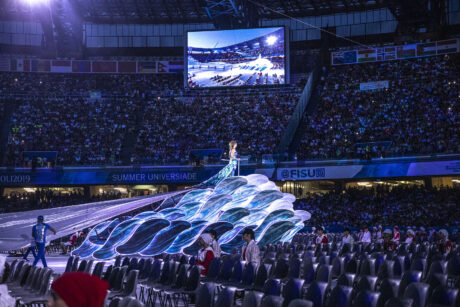
Luckily on the control side, the lighting department were able to hook into the stadium’s newly installed fibre network which made the data cabling a lot quicker and more practical!
Many fixtures including most of the Spiiders and some MegaPointes were deployed on the floor around the field-of-play. The MegaPointes were primarily used as lighting from the roof “I really needed the intensity for the long throws down onto the pitch,” explained Giovanni.
Twenty-eight of the Tarrantulas were rigged on the 28 roof trusses together with two Spiiders and four MegaPointes per 6 meter section. Again, the light weight of the Robes was a factor in the choice of lights considering the loading restrictions on each of the 28 structural pillars around the venue on which these trusses were hung.
The little LEDBeam 150s were deployed to light the scenic elements making up the base of the volcano and along the back of stage deck. This tiny fixture proved ideal for picking out important details in this huge show. Even in a stadium, they made an impact and added their bit to the drama to the bigger picture!
A large U shape on the field of play was outlined in LED lights to represent the Bay of Naples and the artists / performance stage was set up on one of the short-end curves.
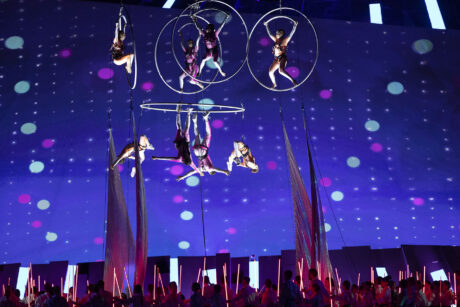
In addition to dramatically lighting the different elements of the event, the ground-based lighting had to be practical enough to be struck immediately after the show finished so the stadium could be prepared for the track and field events to commence first thing in the morning.
The only item that stayed in place was the volcano, as this was also the cauldron for the Olympic flame to burn bright for the duration of the Games.
Giovanni added some rock ‘n’ roll aesthetics to the lighting treatment. “It required a careful balance of dynamic and theatrical lighting for all the big moments, a practical approach for the more formal moments and of course the Athletes parade.” This saw over 6,000 university athletes representing 120 countries.
Giovanni worked alongside his lighting crew chief Fabrizio Moggio and the two of them programmed and ran the show from a grandMA2 console as always.
In addition to the lighting, via a d3 server triggered by the MA2, they ran video content to LED tiles and practical lights inset in the surface panels of Mount Vesuvius and onto a 30 meter long scenery background, upstage center of the performance stage.
As things were extremely fluid right up until the show started, timecode wasn’t a viable option for lighting, so some of that famously accurate manual operation and instinctual timing kicked in to ensure that the show looked amazing.
The biggest overall challenge for lighting was time.
With the assorted sections and parts of the whole OC all having to be rehearsed, and being mid-summer, very little daylight, the core programming was completed – fast and furiously – during 12 intense overnight sessions.
“It was hard work but huge fun at the same time,” said Giovanni, adding that he was “extremely proud” to have been asked to work collectively with such a “truly inspirational and invigorating” creative and technical crew.
The pitch projections were provided by Event Management from Milan with 36 x 30K projectors beaming onto a white mesh surface stretched across the field of play. Each day this had to be removed so the new grass could breathe and photosynthesize! Video content was provided by Clonwerk.
The Volcano and surrounding scenery were delivered by BOTW’s scenic division and designed by Andrea Faini.
The OC show was broadcast and streamed live to 130 countries, all further ramping up the pressure on the all involved in the production.
At the end of a long ceremony, to the delight of the crowds, Italian football megastar Lorenzo Insigne, captain of Napoli and a prominent member of the national team, entered the pitch and kicked a ball that burst not flames on its way up to the top of Mount Vesuvius. Landing in the cauldron it signaled the opening of the 30th Universiade Games … and moments later the event concluded with a truly awesome fireworks finale by Parente Fireworks which saw the stadium erupt in a sensational eye-popping pyro display.
Around a third of the lighting rig stayed in Stadio San Paolo for the closing ceremony which took a more classical route, with a performance stage, multiple artists and lighting also created and run by Giovanni.


